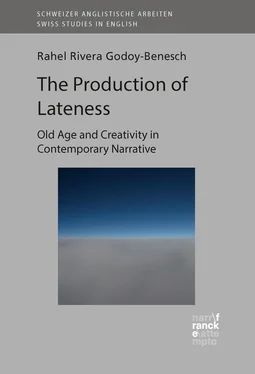Rahel Rivera Godoy-Benesch - The Production of Lateness
Здесь есть возможность читать онлайн «Rahel Rivera Godoy-Benesch - The Production of Lateness» — ознакомительный отрывок электронной книги совершенно бесплатно, а после прочтения отрывка купить полную версию. В некоторых случаях можно слушать аудио, скачать через торрент в формате fb2 и присутствует краткое содержание. Жанр: unrecognised, на английском языке. Описание произведения, (предисловие) а так же отзывы посетителей доступны на портале библиотеки ЛибКат.
- Название:The Production of Lateness
- Автор:
- Жанр:
- Год:неизвестен
- ISBN:нет данных
- Рейтинг книги:5 / 5. Голосов: 1
-
Избранное:Добавить в избранное
- Отзывы:
-
Ваша оценка:
- 100
- 1
- 2
- 3
- 4
- 5
The Production of Lateness: краткое содержание, описание и аннотация
Предлагаем к чтению аннотацию, описание, краткое содержание или предисловие (зависит от того, что написал сам автор книги «The Production of Lateness»). Если вы не нашли необходимую информацию о книге — напишите в комментариях, мы постараемся отыскать её.
The Production of Lateness — читать онлайн ознакомительный отрывок
Ниже представлен текст книги, разбитый по страницам. Система сохранения места последней прочитанной страницы, позволяет с удобством читать онлайн бесплатно книгу «The Production of Lateness», без необходимости каждый раз заново искать на чём Вы остановились. Поставьте закладку, и сможете в любой момент перейти на страницу, на которой закончили чтение.
Интервал:
Закладка:
Yet, universalist tendencies in late-style theories go beyond the simple affirmation that old age will influence an ageing artist’s work; scholars provide catalogues of specific characteristics that such late works arguably display. Joseph N. StrausStraus, Joseph N. assembled a three-page-long alphabetical list with attributes of late style in music as they appear in scholarly work: they go from “abstract”abstraction and “alienatedalienation” (8) to “severe” and “monumental” (10). Recognizing that such a list is “necessarily crude” and that “the categories tend to overlap to some extent” and even “occasionally seem to contradict each other,” Straus proposes that late works should “share at least some of these characteristics, but not necessarily all of them” (7). On the other hand, he also acknowledges that there are contemporary composers in their nineties who are still productive and whose “music continues to develop in interesting ways,” but none of their stylistic developments seem distinctively late (4). In view of this inconsistency, Straus suggests that late style is induced by physical frailtyfrailty and disabilitydisability rather than by biological old age:
Late-style music is understood as having certain distinctive attributes, often including bodily features (fractured, fissured, compact, or immobilized) and certain mental or emotional states (introverted, detached, serene, or irascible). It may be that in writing music describable in such terms, composers are inscribing their shared experiencehuman experience of disability, of bodies and minds that are not functioning in the normal way. (6)
However, even within his universalist approach, Straus allows for the possibility that “listeners and critics, knowing of the composer’s disabilities, [may] read nonnormative physical and mental states into the music” (6), shifting his focus from the composition to the receptionreception of the work.
In view of the difficulty to justify a universalist approach to late style, other scholars argue that stylistic changes in old age may be a universal phenomenon but manifest itself in individual forms, for, as HutcheonHutcheon, Linda and HutcheonHutcheon, Michael affirm, “[t]here are as many late styles as there are late artists” (“Historicizing” 68).1 Imposing “a generalizing concept of late style (in the singular)” onto authors’ works must therefore inevitably result in an ageistageism activity, since it cannot do justice to the individual circumstances in which each author lives and writes (68). The individualist approach to late style, then, is less prone to grand generalizations. However, if the late style of an individual artist is not comparable to any other artist’s, this raises the question of how it can be recognized and assessed. Generally, scholars therefore resort to the comparative-sequential method: they evaluate an artist’s entire oeuvre, comparing earlier with later or last works, and establish meaningful differences in order to group the individual texts, paintings, or compositions into phases. In literary criticism, individualist approaches that set out to distinguish the style of an author’s last work(s) from his or her earlier output can be roughly divided into two groups. Firstly, there are those critics who identify three phases of production in an artist’s lifetime – early, middle, and late – and thus follow the system commonly used in musicology, which is consistent with cultural notionscultural discourse of a human being’s development: youthyouth, middle agemiddle age, and old age. The other group views the last works as an appendix to the main oeuvre whose beginning is marked by a turning point, which the critics duly identify. It may well be that this second method is influenced by one of Theodor W. Adorno’sAdorno, Theodor W. tenets, according to which the “dignity” of a composer depends on whether he will reach a late style in his artistic development (Urbanek 220).2 From this, it follows that, no matter how famous artists are and how well their work is receivedreception at an earlier stage, their oeuvre will require a kind of retrospectiveretrospection authorization by their late work if they wish to be appreciated beyond their middle age. The late work therefore acts as a kind of commentary on the previous creative output.
Whatever individualist approach critics choose, they frequently end up drawing a fairly conventional image of the late author as a creative genius. An example is Adam Zachary Newton’sNewton, Adam Zachary treatment of Philip Roth’sRoth, Philip last four short novels, which Roth himself grouped together under the title “Nemeses.” Newton selects two of these narratives, Indignation and Nemesis , and identifies them as a “prosthesis” in relation to Roth’s earlier works. Newton claims that Indignation and Nemesis are marked by artificiality and, like prostheses, do not pretend to supplant the earlier longer (and arguably more accomplished) novels, as they must naturally fall short of the various functions which the lost ‘body parts’ – Roth’s former novel writing skills – performed. By suggesting that Roth’s earlier works were more elaborate and complete, Newton thus seems to take up popular notions of artistic decline in old age. However, he states that the last works’ artificiality, reductiveness and flatness “possess […] an intrinsic power and ‘fascination’ in [their] own right” (131), affirming the almost magical attractiveness of enigmatic final words and staying in line with the traditional idea that closeness to deathdeath grants wisdomwisdom and transcendencetranscendence. A further individualist study which ultimately reveals traditional late-style concepts is Stephen J. Burn’sBurn, Stephen J. discussion of John Barth’sBarth, John late works. Burn initially contends that “the idea of imminent deathdeath does little to illuminate the signal qualities of Barth’s later fiction” (182). Later, however, he states that “what we find in the fourth-period Barth [i.e. the late Barth] is […] a writer’s meditation on what it means to be at the end ” (187, italics added). Partly, this meaning of being “at the end” is expressed through a distinct, active way of avoiding closureclosure (184), “draw[ing] attention to the figure of the author” in order to create “chains of affect” between author and work (185). In other words – Burn does not put it quite so pointedly – Barth binds himself to his last works in order to affirm his existence and his controlcontrol over his creative products. His latenesslateness thus consists of a strengthening of his own position. Hence, he establishes an image of himself as an artist in his prime, a true late geniusgenius.
Individualist approaches may carry different argumentative thrusts and have different agendas: late-style studies in literature are not always written exclusively to explore texts but also to make a point about old age. Literary gerontologyliterary gerontology is the term for this field (cf. Falcus 54–56). Using literature to explore old age presupposes, however, a close connection between the late stylelate style detected in the works themselves and the physical or mental ageing process of their author. The division of an author’s oeuvre into an early, middle, and late phaselate phase is based on such a connection, and even though a critical study may focus on an individual author, composer, or painter, if it makes use of this universalist division, the results are predetermined. According to Amir Cohen-ShalevCohen-Shalev, Amir, psychological life-spanlife span creativity research has shown that creative expression develops over the life course due to “psychological maturation” (“Self and Style” 298), and the differences between earlier and later phases are marked by the way in which the self positions itself in reference to its outer reality. Works by young artists typically show a “correspondence of self and style,” an “emotional lyricism” and “extreme subjectivitysubjectivity” in which “‘objective’ reality does not have an independent existence; it can be rejected, transformed by the author’s imagination, ignored or magnified, but it is always perceived and responded to from within” (295–296). In middle agemiddle age, in turn, “the need of individuals […] to carve a niche in their community” shows in a concern “with effectiveness in the broader social world [that] often leads to a search for objective information on the external environment” (296). In old age, finally, self and reality “come to maintain an uneasy coexistence” in which “[f]ragmentation by design, incompleteness, internal contradictioncontradiction and emotional ambivalenceambivalence loosen the boundaries between inner and outer realities and enable a two-way flow,” resulting in a “lack of distinction between fact and fantasy, autobiographyautobiography and invention, [and] prose and poetry” (297).
Читать дальшеИнтервал:
Закладка:
Похожие книги на «The Production of Lateness»
Представляем Вашему вниманию похожие книги на «The Production of Lateness» списком для выбора. Мы отобрали схожую по названию и смыслу литературу в надежде предоставить читателям больше вариантов отыскать новые, интересные, ещё непрочитанные произведения.
Обсуждение, отзывы о книге «The Production of Lateness» и просто собственные мнения читателей. Оставьте ваши комментарии, напишите, что Вы думаете о произведении, его смысле или главных героях. Укажите что конкретно понравилось, а что нет, и почему Вы так считаете.












